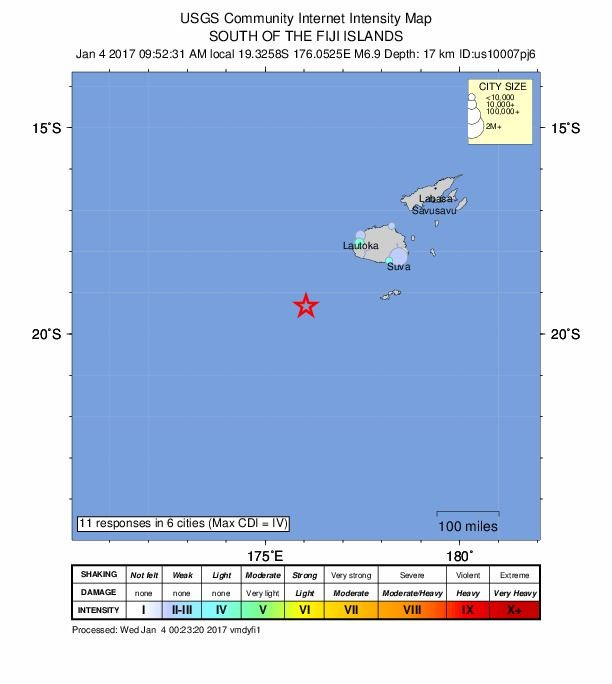Fiji Earthquake 2017: 6.9-Magnitude Tremor Triggers Tsunami Warning

A 6.9-magnitude earthquake struck 176 miles south of Fiji early Wednesday, 6.2 miles below the Earth’s surface in the South Pacific, triggering a tsunami warning, the U.S. Geological Survey reported. A 5.7-magnitude aftershock also was reported.
The initial quake struck at 10:52 a.m., local time.
The Tsunami Warning Center said tsunami waves were possible within 186 miles of the quake’s epicenter but canceled the warning within an hour.
“Government agencies responsible for threatened coastal areas should take action to inform and instruct any coastal populations at risk in accordance with their own evaluation procedures and the level of threat,” the center said in its warning. Despite the cancellation, the center said minor sea level fluctuations still were possible.
The quake produced little concern on parts of Fiji.
“I’m in Nadi and actually didn’t feel anything. I’m coastal too – Wailoaloa Beach – but no sirens or any hint of an emergency here,” journalist Juliette Sivertsen told the Guardian. “A friend from [New Zealand] alerted me to the fact there’s been an [earthquake]. People carrying on as normal around here.”
Earthquake strikes off coast of Fiji sparking tsunami warning https://t.co/B397CMK6aw
— Guardian news (@guardiannews) January 3, 2017
In Suva, companies ordered buildings closed and employees to head to higher ground.
"What I'm seeing is just streams and streams of people walking uphill," Corrine Ambler, who is with the International Federation of Red Cross, told the Wellington Dominion Post.
"There's just a traffic jam, a whole pile of cars trying to get out of town.”
There were no immediate signs of damage.
The Fiji Times reported people at the Sigatoka market were alarmed by the tremor, which lasted 10-15 seconds.
"We are alarmed and want to go home but we're waiting for word from the market master or somebody," vendor Deo Narayan told the Fiji Times.
Earthquakes are not unusual in the area though Wednesday’s quake was outside the norm.
"There are some level of earthquakes in and around Fiji fairly constantly or fairly often but this level of earthquake is unusual and certainly this close to the main islands is unusual and having the resultant tsunami warning is not common,” Red Cross Australia aid worker Susan Slattery told the Australian Broadcasting Network.
Senior seismologist Spiro Spiliopoulos of Geoscience Australia said the quake occurred near the tectonic plate boundary between the Australian and Pacific plates. He said the main temblor also likely was felt on Vanuatu, New Caledonia, Tonga and parts of American Samoa.
© Copyright IBTimes 2025. All rights reserved.






















